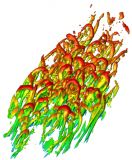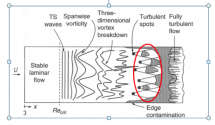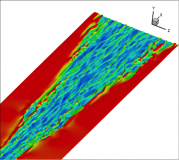Turbulent spots are arrowhead shaped pockets of turbulent that form in the late stages of laminar to turbulent transition process (red circle in the schematic below). These spots increase in size as they travel downstream and form fully turbulent flow as they merge together. My research is looking at the formation and growth mechanisms of turbulent spot as well as interactions of millimeter scale surface textures with spots. If laminar to turbulent transition can be delayed using surface textures, then drag could be reduced.
The simulations are done using a channel flow spectral DNS code modified with immersed boundary to allow for boundary layer simulations. Rex ranges from about 524,000 to 675,000.
- DNS of Surface Textures to Control the Growth of Turbulent Spots
- Sensitivity Analysis for DSMC Simulations of High-Temperature Air Chemistry
- DNS of Surface Textures to Control the Growth of Turbulent Spots
- DNS of Surface Textures to Control the Growth of Turbulent Spots
- Application of Passive Surface Textures to Control the Growth of Turbulent Spots at Moderately High Reynolds Numbers
- Direct numerical simulations of riblets to constrain the growth of turbulent spots
- DNS of Surface Textures to Control the Growth of Turbulent Spots
- DNS of Surface Textures to Control the Growth of Turbulent Spots






